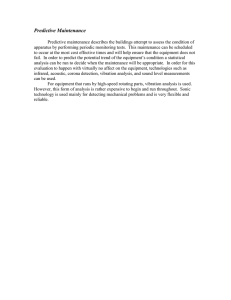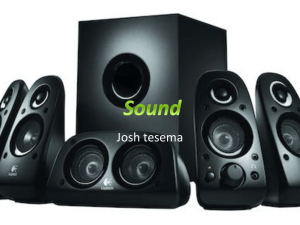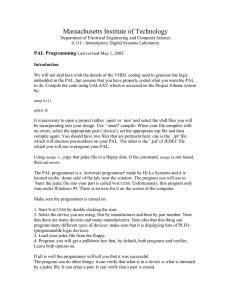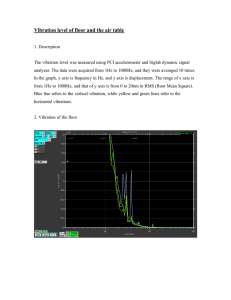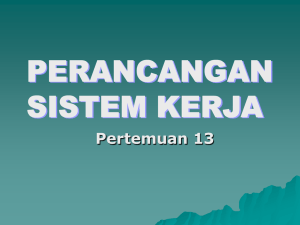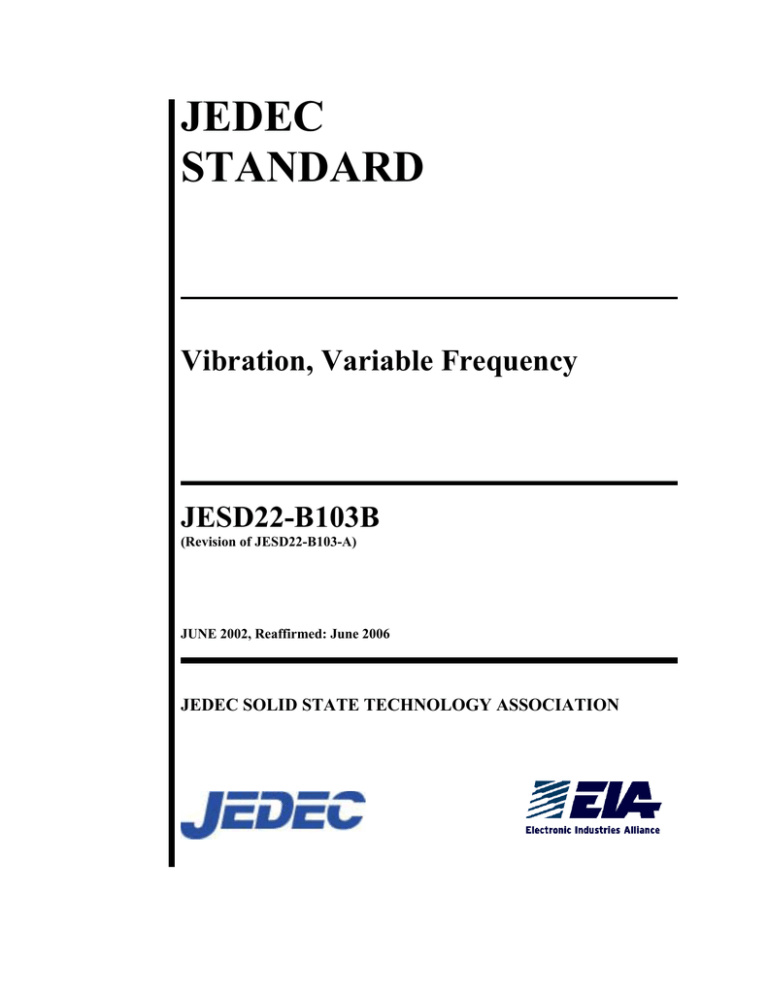
JEDEC
STANDARD
Vibration, Variable Frequency
JESD22-B103B
(Revision of JESD22-B103-A)
JUNE 2002, Reaffirmed: June 2006
JEDEC SOLID STATE TECHNOLOGY ASSOCIATION
NOTICE
JEDEC standards and publications contain material that has been prepared, reviewed, and
approved through the JEDEC Board of Directors level and subsequently reviewed and approved
by the JEDEC legal counsel.
JEDEC standards and publications are designed to serve the public interest through eliminating
misunderstandings between manufacturers and purchasers, facilitating interchangeability and
improvement of products, and assisting the purchaser in selecting and obtaining with minimum
delay the proper product for use by those other than JEDEC members, whether the standard is to
be used either domestically or internationally.
JEDEC standards and publications are adopted without regard to whether or not their adoption
may involve patents or articles, materials, or processes. By such action JEDEC does not assume
any liability to any patent owner, nor does it assume any obligation whatever to parties adopting
the JEDEC standards or publications.
The information included in JEDEC standards and publications represents a sound approach to
product specification and application, principally from the solid state device manufacturer
viewpoint. Within the JEDEC organization there are procedures whereby an JEDEC standard or
publication may be further processed and ultimately become an ANSI/EIA standard.
No claims to be in conformance with this standard may be made unless all requirements stated in
the standard are met.
Inquiries, comments, and suggestions relative to the content of this JEDEC standard or
publication should be addressed to JEDEC at the address below, or call (703)907-7559 or
www.jedec.org
Published by
©JEDEC Solid State Technology Association 2006
2500 Wilson Boulevard
Arlington, VA 22201-3834
This document may be downloaded free of charge; however JEDEC retains the
copyright on this material. By downloading this file the individual agrees not to
charge for or resell the resulting material.
PRICE: Please refer to the current
Catalog of JEDEC Engineering Standards and Publications or call Global Engineering
Documents, USA and Canada 1-800-854-7179, International (303) 397-7956
Printed in the U.S.A.
All rights reserved
PLEASE!
DON’T VIOLATE
THE
LAW!
This document is copyrighted by JEDEC and may not be
reproduced without permission.
Organizations may obtain permission to reproduce a limited number of copies
through entering into a license agreement. For information, contact:
JEDEC Solid State Technology Association
2500 Wilson Boulevard
Arlington, Virginia 22201-3834
or call (703) 907-7559
JEDEC Standard No. 22B103B
VIBRATION, VARIABLE FREQUENCY
Foreword
The variable frequency vibration test is performed to determine the effect of vibration, within a specified
frequency range, on the internal structural elements.
-i-
Test Method B103B
(Revision of B103-A)
JEDEC Standard No. 22B103B
Test Method B103B
(Revision of B103-A)
-ii-
JEDEC Standard No. 22-B103B
Page 1
VIBRATION, VARIABLE FREQUENCY
(From JEDEC Board Ballot, JCB-02-32, formulated under the cognizance of the JC-14.1 Subcommittee
on Reliability Test Methods for Packaged Devices.)
1 Scope
This method is intended to evaluate component(s) for use in electrical equipment. It is intended to
determine the ability of the component(s) to withstand moderate to severe vibration as a result of motion
produced by transportation or field operation. Vibration of this type may disturb operating characteristics,
particularly if the repetitive stress causes fatigue. This is a destructive test intended for component
qualification. It is normally applicable to cavity-type packages.
2 Apparatus
Apparatus for this test shall include equipment capable of providing the required variable frequency
vibration at the specified levels and the necessary optical and electrical equipment for post-test
measurements.
3 Terms and definitions
3.1 RMS acceleration
The root mean square average of the acceleration interval of the dynamic motion.
3.2 Peak acceleration
The maximum of the acceleration interval of the dynamic motion.
3.3 Logarithmic sweep
Continuously varying the frequency in a manner such that within any portion of the frequency range, a
fixed number of decades is traversed in a fixed length of time.
3.4 Octave
A measurement of the spacing of frequency characterized by a doubling of frequency. The number of
octaves, N, between two frequencies, f1<f2, is given by N=(log f2/f1 ) / log 2.
3.5 Decade
A measurement of the spacing of frequency characterized by a tenfold increase of frequency. The
number of decades, D, between two frequencies, f1<f2, is given by D= (log f2/f1) / log 10.
Test Method B103B
(Revision of B103-A)
JEDEC Standard No. 22-B103B
Page 2
3 Terms and definitions (cont’d)
3.6 Decibel measurement of PSD, dB
A measurement of the ratio R of one level of power spectral density, s1, relative to another reference
level, s2, given by the formula R = 20 log (s1 / s2) / log 10. R=6dB is approximately a doubling of power
spectral density from one level to another.
3.7 Power spectral density, PSD
A measurement of the intensity of acceleration power per unit frequency, in units of G squared per Hz.
3.8 Service condition
The designation of the severity of test used to evaluate a component.
3.9 Velocity change
The integral of the acceleration interval of the dynamic motion over the interval.
3.10 Cavity package
A component that has the device located within the cavity of the package body.
3.11 Peak-peak displacement
The maximum difference between highest and lowest values of the displacement of the dynamic motion
interval.
3.12 Gaussian random vibration
Vibration characterized by having acceleration and frequency values over an interval of time which occur
in a stochastic manner, with the acceleration values following a normal (Gaussian) probability density
function and frequency values following a uniform distribution.
4 Procedure
4.1 Component selection
Components subjected to the test will be randomly selected and typical of production. The component
shall be rigidly mounted or restrained by its case with suitable protection for the leads. If component
rework, burn in or other stressful process is to be considered, then such a process or processes should be
applied to the component(s) prior to vibration test. Use of such processes in the test hardware preparation
will be documented in the test results.
Test Method B103B
(Revision of B103-A)
JEDEC Standard No. 22-B103B
Page 3
4.2 Required stress application - swept sine test
4.2.1 Mounting the component
The device case shall be rigidly fastened on the vibration platform and the leads adequately secured to
avoid excessive lead resonance. The components will be mounted in such a manner so that they
experience the full-specified vibration level at the component.
4.2.2 Vibration application
Vibration will be applied to the component outer surface casing or leads in a manner to simulate expected
vibration during processing and packaged shipment. The devices shall be vibrated with simple harmonic
motion corresponding to the test levels shown in Table 1. At least one service condition must be
designated. Each test level will include simple harmonic motion of continuously swept frequency with
the indicated peak-peak displacement below the crossover frequency, and indicated peak acceleration
above the crossover frequency. A tolerance level of +/- 10% on the test being performed, either
displacement or acceleration, is allowed. The test frequency range is from the indicated minimum
frequency to the indicated maximum test frequency. A complete sweep of the test frequency range, from
the minimum to maximum and return to the minimum frequency, shall be traversed in a logarithmic
manner, in 4 minutes. The sweep rate is 1 decade/minute. This complete sweep shall be performed 4
times in each of the orientations X, Y, and Z (total of 12 times). If there are no significant stress
sensitivities of the component under test in a particular frequency range (for examples, in the lower
frequency ranges, or in a region of an uncontrollable fixture resonance), then that portion of the frequency
sweep may be deleted from the stress application with full documentation of the reasons for the test
exception and extent of the portion(s) of the sweep test deleted.
Service
condition
Table 1 — Component test levels
Displacement
Cross-over
Peak acceleration (G)
pk-pk (in / mm)
frequency (Hz)
Min. / Max.
frequency (Hz)
1
20
0.060 / 1.5
80
20 / 2000
2
10
0.040 / 1.0
70
10 / 1000
3
3
0.030 / 0.75
45
5 / 500
4
1
0.020 / 0.5
31
5 / 500
5
0.3
0.010 / 0.25
24
5 / 500
6
0.1
0.005 / 0.125
20
5 / 500
7
0.01
0.001 / 0.039
14
5 / 500
8
0.001
0.0005 / 0.0127
6.2
5 / 500
4.3 Optional stress application - Random vibration test
4.3.1 Mounting component
The device case shall be rigidly fastened on the vibration platform and the leads adequately secured to
avoid excessive lead resonance. The components will be mounted in such a manner so that they
experience the full-specified vibration level at the component.
Test Method B103B
(Revision of B103-A)
JEDEC Standard No. 22-B103B
Page 4
4.3 Optional stress application - Random vibration test (cont’d)
4.3.2 Vibration application
Vibration will be applied to the component’s outer surface casing or leads in a manner to simulate
expected vibration during processing and packaged shipment. The devices shall be vibrated with
Gaussian random vibration corresponding one of the service conditions with associated overall test level
as shown in Table 2. Details of the power spectral density PSD functions for these test levels are given in
Tables 3 - 6 as breakpoints of the curves. Tables 3 - 6 are plotted out in the curves found in Figure 1. In
general, Component test levels A, B and C represent shipping conditions for the component, with
condition A being the most extreme. Test conditions D - I represent various levels of application
vibrations to which a component can be exposed. Condition D is the most severe. Selection of the
appropriate test condition should be based on the actual shipping or application condition requirement for
the component. The vibration will be applied for 30 minutes in each of 3 orthogonal axes, for every
service condition. At least one service condition must be designated, and subjected to the required test
level for a minimum of 90 minutes in total, to complete all three axes.
Table 2 — Overall measures of random vibration test levels
Service
condition
RMS
RMS velocity RMS displacement
(in/sec)
(in)
acceleration (G)
6* RMS
displacement, or 3
sigma pk-pk
displacement (in)
A
6.27
29.0
0.926
5.55
B
3.10
13.2
0.426
2.56
C
1.24
5.22
0.178
1.07
D
1.11
1.64
0.0310
0.186
E
0.686
0.703
0.00543
0.0326
F
0.416
0.425
0.00355
0.0213
G
0.246
0.215
0.00171
0.0102
H
0.123
0.113
0.000832
0.00499
I
0.0626
0.0589
0.000395
0.002237
4.3.3 Test tolerances
The PSD test level will be applied within a tolerance +/- 6 dB of the nominal values at any frequency, and
with an overall tolerance on the RMS acceleration levels of +/- 10%, employing suitable averaging
technique. If there are no significant stress sensitivities of the component under test in a particular
frequency range (for examples, in the lower frequency ranges, or in a region of an uncontrollable fixture
resonance), then that portion of the PSD spectrum may be deleted from the stress application with full
documentation of the reasons for the test exception and extent of the portion(s) of the PSD spectrum
deleted.
Test Method B103B
(Revision of B103-A)
JEDEC Standard No. 22-B103B
Page 5
4.3 Optional stress application - Random vibration test (cont’d)
Table 3 — Frequency breakpoints of power spectral density of component test levels A, B, C
Service condition A
Service condition B
Service condition C
Frequency (Hz)
PSD level, G squared/Hz
PSD level, G squared/Hz
PSD level, G squared/Hz
2
0.01
0.003
0.001
4
1
0.2
0.03
8
1
0.2
0.03
40
0.1
0.02
0.003
50
0.3
0.08
0.013
70
0.3
0.08
0.013
200
0.03
0.008
0.001
500
0.01
0.003
0.001
Table 4 — Frequency breakpoints of power spectral density of component test level D
Service condition D
Frequency (Hz)
PSD Level, G squared / Hz
3
0.0001
6
0.003
40
0.003
50
0.013
70
0.013
200
0.001
500
0.001
Table 5 — Frequency breakpoints of power spectral density of component test levels E, F
Service Condition E
Service Condition F
Frequency (Hz)
PSD Level, G squared / Hz
PSD Level, G squared / Hz
5
0.00002
0.00001
17
0.001
0.0004
40
0.001
0.0004
50
0.01
0.003
60
0.01
0.003
70
0.001
0.0004
150
0.001
0.0004
200
0.0005
0.0002
500
0.0005
0.0002
Test Method B103B
(Revision of B103-A)
JEDEC Standard No. 22-B103B
Page 6
4.3 Optional stress application - Random vibration test (cont’d)
Table 6 — Frequency breakpoints of power spectral density of component test levels G, H, I.
Service Condition G
Service Condition H
Service Condition I
Frequency
(Hz)
PSD Level,
G squared / Hz
PSD Level,
G squared / Hz
PSD Level,
G squared / Hz
5
0.000002
0.0000005
0.0000001
17
0.0001
0.0000022
0.000005
40
0.0001
0.0000022
0.000005
50
0.0008
0.0003
0.0001
60
0.0008
0.0003
0.0001
70
0.0001
0.0000022
0.000005
500
0.00001
0.0000022
0.000005
Figure 1 — Random vibration tests, power spectral density
4.4 Measurements
Hermeticity tests, if applicable, visual examination and electrical measurements (consisting of parametric
and functional tests) shall be performed.
Test Method B103B
(Revision of B103-A)
JEDEC Standard No. 22-B103B
Page 7
5 Failure Criteria
A component shall be defined as a failure if hermeticity requirements cannot be demonstrated, if
parametric limits are exceeded or if functionality cannot be demonstrated under the conditions specified
in the applicable procurement document.
Mechanical damage, such as cracking, chipping or breaking of the package will also be considered a
failure provided such damage was not caused by fixturing or handling and the damage is critical to
component performance in the specific application.
6 Summary
The following details shall be specified in the applicable procurement document:
a) Test service condition, for each test performed.
b) Electrical measurements and results.
c) Sample size and accept number.
d) Disposition of failures.
e) Hermetic leak rate (if applicable).
f) Description of mounting fixture, how component was supported, any pressure applied to component.
g) Description of component, and if applicable, component pre-test stress history.
h) Description of any exceptions to stress application, reason for need for exception, and description of
reason(s) why omission of the stress application will not materially affect test outcome.
Test Method B103B
(Revision of B103-A)
JEDEC Standard No. 22-B103B
Page 8
Test Method B103B
(Revision of B103-A)

